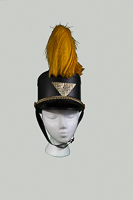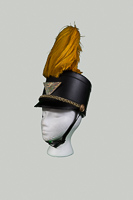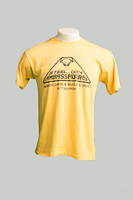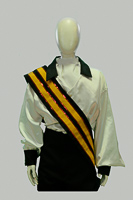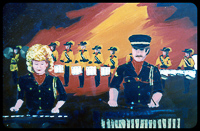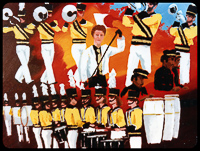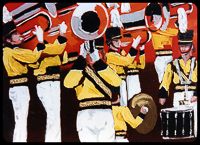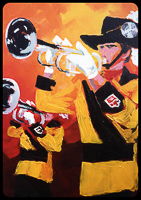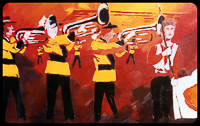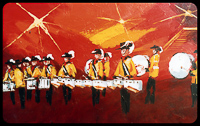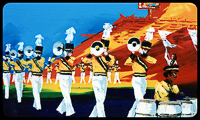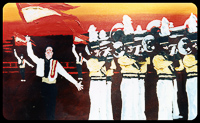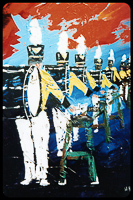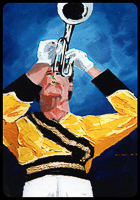Steel City Ambassadors
Pittsburgh, PA United States
Founded: 1981

Senior
CORPS Photos
The story begins in 1980 in western Pennsylvania, home of dozens of fine units from the 1930s through the mid-1970s. But as the steel industry that fueled the Pittsburgh region went into decline, so too did the corps movement. In 1976, however, a group of old Sharpsburg Cadets dusted off their chops for their hometown’s sesquicentennial parade, and some of the guys kept that unit intact as a parade corps, called the Sharpsburg Ambassadors.
Four years later, Dave Fite, former Archer Epler Musketeer soloist, moved to Pittsburgh. Fite knew there was more to drum corps than five or six parades and the occasional standstill concert. One night after practice Fite proposed a plan to build a competitive senior corps out of all the untapped local talent. To kick things off he organized a giant reunion party that drew over one hundred former corps members. This nucleus responded to Fite’s call to form a new corps in August of 1980.
The new Steel City Ambassadors took fledgling steps, joined the ICA and DCA, and performed at Larry Hersheman’s Westshore standstill in Harrisburg. Steel City had a pretty strong horn line featuring some top-notch solo talent. The drum line took longer to gel; good percussion instruction was hard to come by. This fact was to haunt the corps throughout its existence.
Getting the corps onto the field became a comedy of errors as no less than four drill instructors were hired, then fired. Larry Tinnerman, a part-time horn instructor during the winter, was brought in to perform emergency drill surgery a mere two weeks before the first show in Midland, Pennsylvania, on July 4. Tinnerman worked miracles, getting eleven minutes of drill written and taught in less than a fortnight, and teaching the exit in the last two hours of rehearsal on the Fourth itself.
Midland was an old steel town, blue collar and traditional, but the crowd that evening roared with approval for this new unit from Pittsburgh. It seemed as if they were going to tear the stands down when this novice group was announced as finishing second to the Erie Thunderbirds.
The corps performed at a few more ICA shows and one DCA competition. Based on their scores, they looked to be a safe bet to earn tenth place at DCA Prelims, the only competitor of concern being the resurrected Archer Epler Musketeers.
DCA weekend was a total shock. Both Archie and Steel City were left on the outside as the Niagara Regionaires, a Canadian unit that had never beaten either group, leapfrogged into the tenth spot. Rumors flew about the “reserved spot” for a Canadian corps, to make DCA an “international” organization.
1982 began optimistically. Steel City had grown in size and talent, with an improved guard. Frank Miller, who had taken over percussion instruction the previous summer, performed miracles with the drummers. Steel City dominated ICA, winning their first show in East Liverpool, Ohio, at the end of June and going undefeated, capturing the title easily. The climb continued into DCA, as the corps finally overcame Erie and traded wins with Archie.
Prelims was another disappointment, however, as the Pittsburgh group found themselves in eleventh place. One of the saddest moments in this unit’s history came when members learned that they had lost to both Archer Epler and to a corps that had appeared out of nowhere, the appropriately named Bushwhackers.
The second near miss at Prelims nearly tore the corps apart, but Steel proved as tough and resilient as its name, vowing to become even better. The 1983 drum line was downright enormous, featuring six base drums and eleven snares. The horn line checked in at 48, and the guard featured its first ever rifle line. The competitive season continued previous years’ patterns as the group remained undefeated in the ICA but had trouble impressing DCA judges. In the end, they cracked the top ten, at tenth place, on Finals night, and the corps’ huge drum line had the honor of playing all corps on at retreat that night in Allentown.
The goal of DCA membership had been reached, but Steel City still suffered growing pains. The brass talent was there and Miller’s drumline was solid, but the corps continued to have problems in drill design (parts of the 1983 drill had been drawn on cocktail napkins in a bar at corps camp) and marching instruction. The corps needed a change. Soprano Ken Behrend knew an instructor from New York and brought him in to take over drill design, teaching, and staff coordination. This man, Rick Morey, turned out to be the most important person ever to be associated with the Steel City Ambassadors.
Personnel and management shakeups resulted in a smaller corps. The drill was written for forty horns, the guard was tiny at thirteen, and the drum line had shrunk to fewer than twenty. Morey did not care because the smaller numbers worked to the group’s advantage. Rick was an innovative designer, producing drills that featured great asymmetrical forms, smooth transitions, and quick hitting sets. No one was a better teacher/motivator. Rick commanded the respect of the entire corps, and he could make anyone feel better, try harder and put bitter feelings behind them.
The corps also hired Steve Cooley to write the horn book. Steve’s charts challenged the horn talent, and the quality of the work soon became apparent. The Ambassadors may have been smaller than in previous years, but the line was never tighter.
The 1984 ICA season found Steel City facing a new corps from upstate New York, the entertaining but raw Empire Statesmen of Rochester, This was the corps who ended Pittsburgh’s two-year win steak in ICA with a victory in Canada early in the season. Steel City traded wins with the Statesmen, and then tied them at the ICA championships.
Expectations of a rise in DCA ranking that year proved justified. The Ambassadors ended up in a seventh place tie with Le Cascadeurs, another one of those “flash in the pan” French Canadian units that appear periodically in DCA and soon disappear. However, the men from Pittsburgh had achieved a drum corps first: no corps has ever tied at two championship Finals in the same year.
Most Steel City veterans would tell you that the corps’s fifth year was its best in terms of spirit and morale. Morey and Cooley returned, and a fresh recruiting effort yielded a huge corps, featuring 58 horns, a full drum line, and a 25-man guard. Former 27th Lancer drum major Billy Marshall took over as marching instructor, new horn techs were brought in, and new uniforms appeared.
The season opened at Hershey with a win over the New York Skyliners, which had suffered severe personnel problems that winter; this was their first defeat ever at the hands of a Pittsburgh corps. During the course of that season Steel City beat Sky regularly and reached their preseason goal, taking fifth place in DCA Finals, having beaten everybody except Hawthorne, Reading, Sun, and Bush.
Nineteen eighty-six was something special. A new influx of personnel and staff over the winter served notice that the Steel City Ambassadors were going to be a force in DCA. The show retained only one tune from previous seasons, “Stormy Weather,” featuring champion soloist Curt Hawkins. The new repertoire included “Somewhere,” “One More Time Chuck Corea,” “Nutville,” and “After You’ve Gone“ as the closer. Billy Marshall took over as podium drum major. Winter practices were huge, and the brass line reached sixty horns. The drum line was full, and the corps was fronted by 28 guard.
At the Westshore Standstill, Larry Hershman gave the Ambassadors the chance to go on stage after Hawthorne, the undefeated back-to-back champions. This was a gamble, but the corps accepted the challenge and performed the standstill of their lives, which led to a roaring standing ovation.
This rousing season opener provided the momentum to catapult Steel City into the competitive season. The first show was Hershey, and they would be up against Hawthorne and three others. The performance was inspired, and that central/western Pennsylvania crowd was enthused. That show got no fewer than four standing ovations. On the field for the retreat ceremony no one could believe their ears when the Caballeros were announced in second place, as five thousand Pennsylvania partisans roared their approval. Barely five years old, Steel City had handed the perennial champs their first setback in over two years.
The next week the corps floored all comers at Rutgers, New Jersey, a triumph that included a caption sweep. They won at Carlisle before a minor setback in Scranton. A week before DCA the corps performed a powerful show in a monsoon-like downpour at Lewistown, Pennsylvania. Judging had been called off, but Steel City was clearly several points ahead of Reading and Bush. A head of steam was propelling the corps into Allentown.
Three years before, the new corps from Pittsburgh had been hoping to make DCA’s top ten; now they were actually looking at winning the title. They tied Hawthorne for first in Prelims, and Steel City performed last at Finals, having won the coin flip. They marched off that night feeling like champions.
Retreat was full of the usual nonsense, and it had gotten chilly as it always seems to do. The caption awards were read: High Drums: Bushwhackers. No big surprise there; the Harrison crew was well noted for their percussion excellence. High Horns: Bushwhackers. It suddenly got chillier yet. The High GE trophy came Steel City’s way, not unexpectedly, but then the top M&M award went to Hawthorne. The writing was on the wall. The final tally was Bush, 92.4, Steel City, 91.9. The Ambassadors had beaten Hawthorne, but the Bushwhackers, again living up to their name, had been close enough to win it with a good performance, increasing their lead in percussion by almost a point and a half. The whole season had come down to that.
Choking back tears, Billy called Steel to attention. The other corps had exited the field, leaving just Steel and Bush. Billy marched the runners-up over to the confused Bushwhackers, halted them, and played “Somewhere” to salute the winners. This brought tears to several Bushwhackers. Their drum major brought them to attention and a tenor drummer was heard to say, “We’ve come a long way from ICA!” The number one and two corps in DCA had not even existed six years earlier.
The goal for 1987 was finally to take the title the corps felt should have been theirs. The horn line got bigger (64 members), and Morey wrote his best drill yet, making much greater use of the corps’ size over more of the field. The repertoire retained “One More Time” and “Nutville,” added “Somewhere Out There” and “Come Rain or Come Shine,” a combination that prompted wits to remark that the show perpetuated the Steel City tradition of precipitation and location adverbs.
The Ambassadors were better that season, but so were the other senior corps who were reaching for the bar that Steel had raised in 1986. The Allentown weekend was wet. Saturday night was a deluge, and Prelims were held in a steady shower; the field became a quagmire. At the end of the day, Steel City was in fourth place, behind Hawthorne, Bush, and the resurgent Sunrisers, but less than two points separated the top four corps and, as all had seen last year, anything could happen. Finals could not be held that evening, so the corps retired to their hotels to await the decision. If foul weather continued, Finals would be cancelled and Prelim scores would stand.
The corps had one of their best rehearsals that Monday morning, really pulling together. The horn line was in its semicircle tuning when corps business manager Tom Mahan drove up with the news that Finals had indeed been cancelled. Members began to drift away in sadness, shock, confusion, and disgust when Cooley yelled out, “Wait! We’re not finished yet! Get back here!” When the whole line was ready, Steve conducted the last performance of the 1987 show. Visibly shaken he said haltingly, “This isn’t for DCA or the judges or anyone else. This is for us!” And they played like they never had before, as the second consecutive season ended in disappointment.
The rest is anticlimax. Steel City attempted to go in another direction in 1988 with an unfortunate “sweet swing” show. The horn line was used to playing with dynamics and emotion, but this controlled show sapped them of their energy. Steel City finished eighth with an 83.00, falling four spots. The drum line finished ninth while the horns were fifth, only seven tenths behind Bush. No section of the corps worked harder than the percussionists, but they just could not put it over the top at the end.
In 1989 the Ambassadors returned to their roots with an exciting Latin-based show and a smaller, tighter unit. Interestingly, the Skyliners leapfrogged both Steel City and the Crusaders in Finals to finish sixth.
The Ambassadors were lined up next to Rochester at retreat. When the tie was announced, corps members broke ranks, intermingling, shaking hands, hugging, laughing, and having a ball mocking DCA and the absurdity of the situation. Steel City marched off together playing what Rick Morey later called “the loudest f***ing F-Scale I have ever heard in my life!”
Nineteen eighty-nine was the last hurrah, and the subsequent decline came quickly. In 1990 Steel City attempted to copy the Madison Scouts’ 1988 formula for winning with “Suite for Jazz Orchestra” and “Malaguena,” but their unrealistic dreams of the title went unfulfilled with a seventh-place finish.
Smaller units took the field in 1991 and 1992. Personnel problems, budget pressures, and staff disputes all exacted their toll. The entire board of directors resigned in January, 1991, and the corps barely made it to the field. The corps was on its last legs in the spring of 1993. A proposed merger with a Johnsonburg corps failed a week before camp, and the Ambassadors officially folded its tents.
The Steel City Ambassadors had come out of western Pennsylvania, a senior corps backwater, and had risen through the ranks to win a reputation for entertaining performances and showmanship. In 1986 and 1987 they stood near the top of the DCA world, but could not quite take that last step. In the end, however, the corps left its mark, improved the standards of senior corps, and entertained a lot of people. And that is a pretty substantial contribution after all.
[Bob Diethrich]
-
1981 3 scores
Highest Score 57.900
Final show in DCX Archives September 6, 1981 DCA Championships Prelims Philadelphia PA placed 12 with a score of 57.900
-
1982 5 scores
Highest Score 72.400
Final show in DCX Archives September 5, 1982 DCA Championships Prelims Allentown PA placed 11 with a score of 64.300
-
1983 8 scores
Highest Score 74.150
Final show in DCX Archives September 4, 1983 DCA Championships Prelims Allentown PA placed 10 with a score of 68.550
-
1984 2 scores
Highest Score 75.350
Final show in DCX Archives September 3, 1984 DCA Championships Allentown PA placed 7 with a score of 74.200
-
1985 2 scores
Highest Score 82.200
Final show in DCX Archives September 1, 1985 DCA Championships Prelims Allentown PA placed 5 with a score of 81.950
-
1986 6 scores
Highest Score 91.950
Final show in DCX Archives August 31, 1986 DCA Championships Prelims Allentown PA placed 1 with a score of 89.650
-
1987 7 scores
Highest Score 92.860
Final show in DCX Archives September 6, 1987 DCA Championships Prelims Allentown PA placed 4 with a score of 92.860
-
1988 8 scores
Highest Score 84.140
Final show in DCX Archives September 5, 1988 DCA Championships Prelims Hershey PA placed 7 with a score of 84.140
-
1989 10 scores
Highest Score 89.500
Final show in DCX Archives September 3, 1989 DCA Championships Prelims Allentown PA placed 7 with a score of 89.500
-
1990 10 scores
Highest Score 88.900
Final show in DCX Archives September 2, 1990 DCA Championships Prelims Allentown PA placed 8 with a score of 88.700
-
1991 6 scores
Highest Score 78.300
Final show in DCX Archives September 1, 1991 DCA Championships Prelims Scranton PA placed 12 with a score of 73.400
-
1992 6 scores
Highest Score 77.900
Final show in DCX Archives September 6, 1992 DCA Championships Prelims Scranton PA placed 14 with a score of 77.900
-
2016 1 scores
Highest Score 0.000
Final show in DCX Archives September 4, 2016 Alumni Spectacular Rochester NY
Members (37)
| Member Name | Section | Years Involved |
|---|---|---|
| Adams, Warren | Contra Bass | 1989 |
| Adams, Warren | Baritone | 1991 to 1993 |
| Beatty, Bob | French Horn | 1985; 1987 |
| Bell, Donnett | Pit / Percussion Staff | 1985 to 1986 |
| Butcher, Markus | Euphonium | 1989 |
| Cavanaugh, Pat | French Horn, Staff | 1981 to 1988 |
| Chase, Rob | Hornline | 1986 to 1987 |
| Chase, Rob | Brass Instructor | 1990 to 1992 |
| Cooley, Stephen | Brass Arranger/Instructor | 1984 to 1991 |
| Cribbs, Jay | Contra Bass | 2005 |
| Danchik, Jeff | soprano | 1981 |
| Delaney, Bob | Soprano | 1984 |
| Dugan, Ray | Staff | 1989 |
| Dunn, Jerry | Lead Soporano | 1986 to 1988 |
| Fine, Dale | Baritone | 1987; 1993 |
| Foremsky, David | Contrabass | 2002 |
| Gruphofer, John | Baritone | 1980 to 1993 |
| Hannah, Brian | french horn | 1986 |
| Henley, Scott | Soprano | 1985 to 1992 |
| Johnson, Scott | Percussion | 1990 to 1992 |
| Johnson, Walt | percussion | 1991 to 1993 |
| Johnson, Walt | percussion | 1991 to 1993 |
| Kennedy, Rick | Snare | 1988 to 1990 |
| Knisely, Deb | contra | 1985; 1987 to 1991 |
| Labetti, Lou | Contra | 1992 to 1993 |
| Leopold, Steve | Mellophone | 1989 to 1992 |
| McPherson, Jay | Contra | 1981 to 1988 |
| Menear, Bob | Lead Soprano | 1981 to 1982 |
| Menear, Bob | Drum Major, Horn Instructor | 1984 |
| Metzger, Paul | Mellophone | 1981 to 1983 |
| Meyette, Chuck | Contra | 1989 to 1993 |
| Staton, Skip | Contra | 1987 |
| Sweney, Gregg | Lead Soprano, Mellophone | 1981 to 1982 |
| Tinnerman, Larry | Drill Designer | 1981 |
| Tinnerman, Larry | Baritone | 1984 |
| Tinnerman, Larry | Brass Staff | 1986 to 1988 |
| Zamperini, Mar-Jean | Snare Drum & Baritone | 1989 to 1991 |
CORPS 24 items

Steel City Ambassadors Rob Jacket from the Bill Ives Collection Contributed by Larry Eckert

Steel City Ambassadors Rob Jacket from the Bill Ives Collection Contributed by Larry Eckert
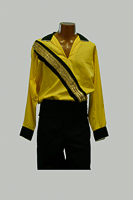
Steel City Ambassadors 1984 Uniform 1984 from the Bill Ives Collection Contributed by Bill Murray
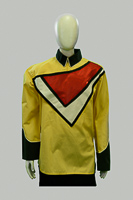
Steel City Ambassadors 1984 Uniform 1984 from the Bill Ives Collection Contributed by Bill Murray
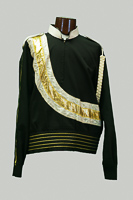
Steel City Ambassadors Gold Sash from the Bill Ives Collection Contributed by Bill Murray

SteelCityAmbassadors,Pittsburg,PA,Patch1-IronLadle(Site)AA_U_S from the Richard Elmquist Collection

SteelCityAmbassadors,Pittsburg,PA,Pin1(BJA)AA_U_S from the Richard Elmquist Collection

SteelCityAmbassadors,Pittsburg,PA,Pin2-Excellence(RCR)AA_U_S from the Richard Elmquist Collection

SteelCityAmbassadors,Pittsburg,PA,Pin3-AmbassadorClub(RCR)AA_U_S from the Richard Elmquist Collection
PDF Document

396-397, Steel City Ambassadors from the Steve Vickers Collection
LOADING.....




